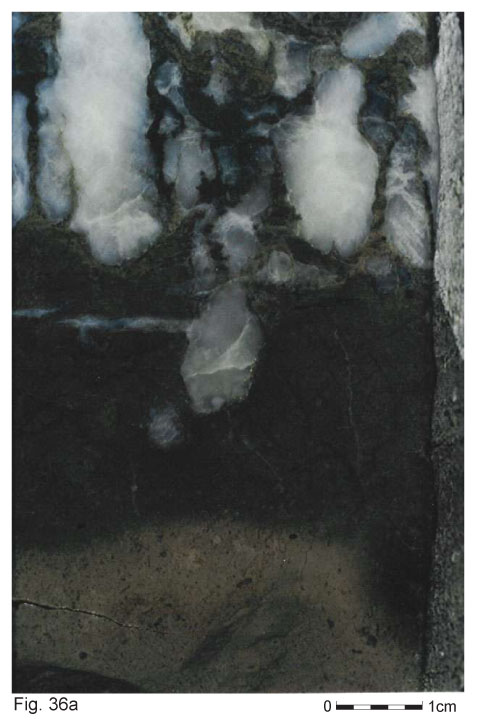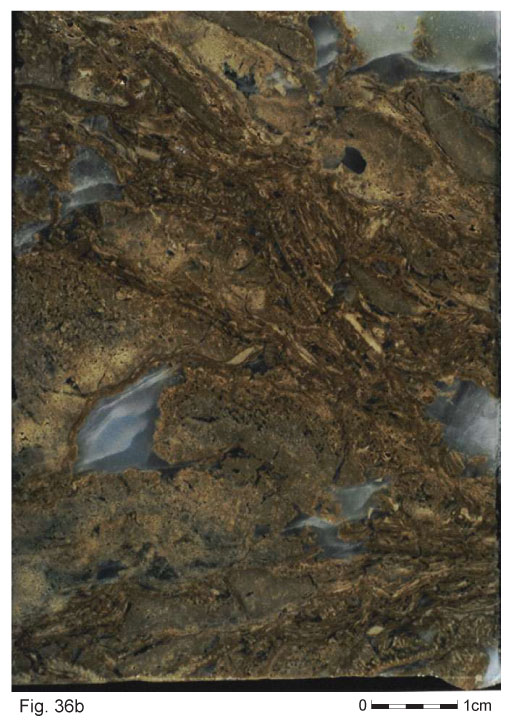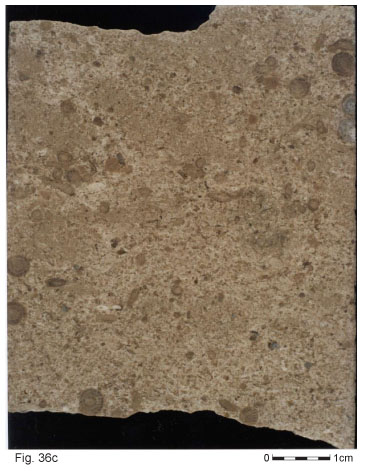 |
|
 |
|
From the Norwegian name for an eagle (3 species, including the Sea Eagle Haliaetus albicilla, are found in the northern Norway).
The type section is defined as the interval from 2050 m to 1834.5 m in well 7128/6-1 on the Finnmark Platform (Fig. 30; Table 1). The upper boundary corresponds to 1836.2 m in core depth (Fig. 31). The base of the formation is defined at a change towards overall lower readings on the gamma ray log and a less noisy gamma ray pattern, reflecting the dominance of carbonates (Fig. 30). The formation corresponds to units L-3 to L-7 of Ehrenberg et al. (1998a) in this type well.
Fig. 30. Well logs of the type section of the Ørn Formation in 7128/6-1.
For explanation of symbols see Fig. 3.

Fig. 31. Sedimentological log of the core through the entire type section of the Ørn Formation in 7128/6-1.
For explanation of symbols see Fig. 3.

Reference sections:
Reference sections are provided by the intervals:
2024.0 m to 1945.0 m in 7120/2-1 (Fig. 20) and from TD at 5000 m to 3990 m in 7121/1-1 (Fig. 32), both on the Loppa High; in 7120/2-1 the base is marked by a pronounced drop on the gamma ray curve and the preserved part of the formation is characterised by uniformly low gamma ray values.
5137 m to 4334.5 m in 7226/11-1 on the Bjarmeland Platform (Fig. 33; Table 1);
1952 m to 1820 m in 7128/4-1 (Fig. 26), 426.7 m to 334.7 m in 7030/03-U-01 (Fig. 34); 383.8 m to 319.6 m in 7029/03-U-02 (Fig. 35); and 455.9 m to 399.6 m in 7129/10-U-02, all located on the Finnmark Platform (Table 1).
Fig. 32. Well logs showing reference section through the Ørn Formation in 7121/1-1
For explanation of symbols see Fig. 3.

Fig. 33. Well logs of the Gipsdalen Group in 7226/11-1 on the Bjarmeland Platform showing the reference section of the Ørn Fm. For explanation of symbols see Fig. 3.



The Ørn Formation is 215 m thick in 7128/6-1 and 132 m thick in the adjacent 7128/4-1 well; a composite thickness of 150 to 200 m is also recorded in the IKU cores further south on the Finnmark Platform. The formation thickens northwards to about 246 m in well 7228/9-1S and to 358 m in 7229/11-1 near the platform’s northern margins. It is about 800 m thick in well 7226/11-1 and probably about 1000 m thick in and under 7124/3-1 on the southern margins of the Bjarmeland Platform. Further to the west, on the southern margins of the Loppa High, the formation is over 1000 m thick in well 7121/1-1, while it thins and is progressively eroded updip so that only 79 m are preserved in well 7120/2-1 near the crest of the high.
The formation is dominated by shallow marine carbonates on the platform areas and interbedded carbonates and evaporites in the more distal ramp to basinal settings. The carbonates contain a warm-water biota dominated by small foraminifers, fusulinids and calcareous algae and with abundant fragments of Palaeoaplysina (Fig. 36, Fig. 37). Crinoids, bryozoans, brachiopods and corals are also present. Siliciclastics are rare in the Ørn Formation and the vast bulk of its rhythmic development is characterised by pure carbonates, or more distally, carbonates and evaporites - in contrast to the mixed siliciclastics and carbonates of the underlying Falk Formation. A temporary return to mixed carbonates and shales near the top of the formation is characterised by a gamma ray peak on the logs.
Fig. 36. Core photos of the Ørn Formation: The Ørn Formation contains limestones, dolomites, and evaporites (a), together with subsidiary marls and shales. Greyish to yellowish brown dolomitic wackestone to boundstone with abundant palaeoaplysinid – phylloid algal skeletal fragments (b) are interpreted as reef mounds. The mounds are associated with packstones/grainstones (c) with anhydrite nodules/cements (a: 7128/6-1 at 2023 mRKB, b: 7128/6-1 at 1950 mRKB. c: 7128/6-1 at 1874 mRKB).
 |
 |
 |

In well 7128/6-1, the lower part of the formation consists of rhythms of dolomitic mudstone and bryozoan wackestone with minor thin shales (Fig. 30, Fig. 31, Fig. 36, Fig. 37). This is followed by a succession of Palaeoaplysina-dominated buildups interbedded with fusulinid-dominated wackestone, overlain by an interval dominated by dolomitic mudstone with abundant anhydrite nodules. The upper part of the formation in this well consists of a thick unit dominated by foraminifer- and algal-rich packstones and grainstones overlain by cyclic deposited shales and crinoid-dominated silty wackestones that gradually pass up into foraminifer-dominated packstones and grainstones. The same spectrum of shallow marine carbonate facies is seen in cores from 7120/2-1, 7128/4-1, 7029/03-U-02, 7030/03-U-01, 7129/10-U-01 and 7129/10-U-02, suggesting a fairly uniform development on the platforms. In addition more than 5 m thick beds of massive to laminated anhydrite occur in 7029/03-U-02 and 7030/03-U-01 and native sulphur is locally present between 20 m and 35 m in 7029/03-U-02.
In well 7226/11-1 the lower part of the Ørn Formation consists of light grey to medium dark brownish grey dolomitic mudstones to packstones. These are interbedded with light grey to white massive anhydrite that increases in abundance upward to 4392,5m. Above this level rhythms of dark greyish-green calcareous shale and light grey fossiliferous limestone with chert nodules dominate. This unit is equivalent to the upper part of 7128/6-1. Log correlation suggests that the development in well 7226/11-1 resembles that of other distally located wells such as 7121/1-1 and 7124/3-1. Well 7228/9-1 cored thin dolomite and anhydrite beds in halite-dominated sediments.
Well data and seismic data indicate that the formation is thinly developed and carbonatedominated on the inner platforms (e.g. 7128/6-1 and 7128/4-1). It becomes significantly thicker and anhydrite-rich more distally on the platforms (e.g. 7226/11-1, 7124/3-1 and 7121/1-1), and in the basins the presence of salt diapirs indicates a dominance of halite. Seismic data indicate stacking of carbonate buildups into larger mounds along the platform margins (e.g. Elvebakk et al. 2002).
The base of the Ørn Formation is highly diachronous since it records the final drowning of local siliciclastic provenance areas. As noted previously, the formation’s carbonates directly onlap basement in 7226/11-1. The top of the formation is represented by a subaerial exposure surface in the type well 7128/6-1. This is situated a few tens of metres above the top of a high amplitude seismic reflector mapped as ”the Top Asselian seismic marker” throughout the Barents Sea.
Fusulinid data from the type well 7128/6-1 indicate a late Gzelian to early Sakmarian age for the Ørn Formation at this locality (Ehrenberg et al. 1998a). In core 7030/03-U-01 the base of the formation correlates to the Kasimovian-Gzelian boundary and in 7029/03-U-02 the lower part of the formation is of middle Gzelian age (Stemmerik et al. 1995). The top of the formation is dated as early Sakmarian in core 7129/10-U-02 (Bugge et al. 1995). The base is somewhat older in 7120/2-1 where fusulinids indicative of a late Moscovian age occur in the basal part of the formation (Stemmerik et al. 1998).
The Ørn Formation is characterised by sediments deposited as a response to high frequency and high amplitude fluctuations during times of high second order sea level (Stemmerik 1997; Stemmerik et al. 1998). Siliciclastic provenance areas were now drowned and deposition on the platforms took place in a variety of shallow marine carbonate environments. Locally extensive sabkhas developed updip and thick units of dolomitic mudstone with anhydrite nodules belonging to the lower part of the Ørn Formation occur on the Finnmark Platform. Large carbonate mounds developed more distally on the platforms as a result of stacking of smaller buildups; the internal composition of these large mounds is still unknown. Interbedded subtidal highstand carbonates and lowstand anhydrite characterise the deepest parts of the platform, whereas halite deposition in the basin centres is suggested to have taken place during major lowstands when platforms were subaerially exposed and the basins were partly or totally separated from the open sea.
A major flooding event near the Asselian-Sakmarian boundary changed depositional conditions on the platforms and the upper part of the formation is characterised by rhythms dominated by outer shelf marls and wackestones that pass up into packstones.
The formation correlates generally to the Kapp DunГ©r Formation on Bjørnøya, although deposition of that unit apparently terminated in the Asselian and was followed by appreciable uplift and tilting through the Sakmarian (Worsley et al. 2001). The Palaeoaplysina buildups typical of the Kapp DunГ©r Formation provide excellent analogues for those of the Ørn Formation (Worsley & Edwards 1976; Lønøy 1988; Stemmerik & Larssen 1993; Stemmerik et al. 1994), while inter-buildup deposits on Bjørnøya suggest highly variable hypersaline to normal marine conditions (Siedlecka 1972, 1975; Folk & Siedlecka 1974). Tectonic activity continued in Hornsund, as witnessed by spectacular intraformational conglomerates of the upper Treskelodden Formation with large reworked coral clasts (c.f. Fedorowski 1982). In contrast, the remainder of the Svalbard Platform was relatively stable at the time and most of Spitsbergen and the northern Barents Shelf was covered by deposits of the Wordiekammen and Gipsdalen formations (Dallmann et al. 1999); Palaeoaplysinid buildups also occur on Spitsbergen, especially along the margins of the still subsiding Billefjorden Trough (Skaug et al. 1982).